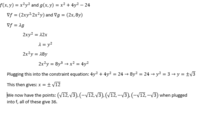I was given the following question:
Find the maximum and minimum of the function \(f(x,y)=x^2y^2\) subject to \(x^2+4y^2=24\).
I tried using lagrange multipliers and got the following:

I was assuming that I would get different answers, and that the biggest one would be the maximum and the smallest would be the minimum. This did not happen. Where did I go wrong, and what steps can I take to solve this problem?
Find the maximum and minimum of the function \(f(x,y)=x^2y^2\) subject to \(x^2+4y^2=24\).
I tried using lagrange multipliers and got the following:

I was assuming that I would get different answers, and that the biggest one would be the maximum and the smallest would be the minimum. This did not happen. Where did I go wrong, and what steps can I take to solve this problem?
